The Devastating Impact of Fast Fashion on the Environment
The fashion industry has long been criticized for its negative impact on the environment, but the rise of fast fashion has taken this issue to a whole new level. The Atacama Desert in Chile serves as a stark reminder of the consequences of our insatiable appetite for new clothes. Satellite images capturing mountains of discarded garments paint a grim picture of the environmental havoc wreaked by our throwaway culture.
The discarded clothes in the Atacama Desert are a result of our obsession with fast fashion – the rapid production of cheap, trendy clothing that encourages consumers to constantly buy new items. This cycle of consumption not only depletes valuable resources but also generates massive amounts of waste that our planet simply cannot sustain. The sheer volume of clothing being produced and discarded is overwhelming, leading to environmental disasters in countries like Chile and Ghana.
The Journey of Discarded Clothes
When we discard our clothes, they often end up in landfills or incinerators, releasing harmful chemicals and greenhouse gases into the atmosphere. However, many of our unwanted garments find their way to thrift shops, resale boutiques, or clothing donation bins. While these may seem like responsible choices, the reality is that the global secondhand clothing market is flooded with excess inventory, much of which cannot be sold or donated locally.
As a result, a significant portion of our discarded clothes is shipped to developing countries where there is a demand for affordable clothing. This influx of secondhand garments overwhelms local markets, displacing indigenous artisans and hindering the growth of domestic textile industries. Moreover, many of these clothes have been treated with chemicals or contain synthetic fibers that do not break down easily, further contributing to environmental pollution.
The Human Cost of Fast Fashion
In addition to its environmental impact, fast fashion also takes a toll on the lives of garment workers around the world. The relentless demand for cheap clothing drives manufacturers to cut costs at the expense of labor rights and safety standards. Workers in countries like Bangladesh, India, and China often toil in unsafe conditions for meager wages, facing exploitation and abuse on a daily basis.
The Rana Plaza factory collapse in Bangladesh in 2013, which claimed the lives of over 1,100 garment workers, was a tragic reminder of the human cost of fast fashion. Despite calls for improved labor practices and greater transparency in the supply chain, many fashion brands continue to prioritize profit over the well-being of their workers. As consumers, we must demand accountability from the companies we support and advocate for fair wages and safe working conditions for all garment workers.
In conclusion, the impact of fast fashion on the environment and human rights cannot be overstated. It is imperative that we rethink our approach to clothing consumption and prioritize sustainability over trends. By supporting ethical and eco-friendly brands, embracing slow fashion, and reducing our overall consumption, we can work towards a more sustainable future for both the planet and its inhabitants.



























